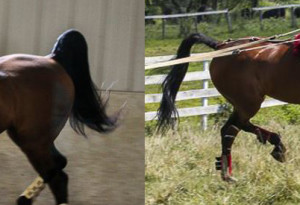There’s nothing more beautiful than a long, flowing tail on a Saddle Seat show horse. It’s a lot of work to grow (and keep!) a long tail. And no matter how long the tail is, there’s nothing uglier than not having feathers at the top. I’ve struggled with a few horses in the past (and my current one!) that liked to rub their tail. AUGH! Talk about frustrating. So I’ve had a lot of time to figure out why horses rub, ways to prevent it, and then some things to do that encourage new hair growth.
How to Stop the Rubbing
It’s the million dollar question… “how do I get my horse to stop rubbing his tail?” Everyone has a different answer. And some of those answers work… some of the time. So I have a checklist I run through when my horse starts rubbing. Through trial and error, I’ve pretty much determined these are the reasons why he rubs, in order of most likely to least likely.
- Sheath needs to be cleaned (or in the case of a mare, her teats). Most geldings can go about 5-6 months between cleanings without trouble. But my horse needs it done every 3-4 WEEKS. If it goes beyond that, he will start rubbing like clockwork. Fortunately for me, my horse doesn’t mind having his sheath cleaned. I like to use Excalibur or something similar that is made specifically for the job. Don’t use shampoo or soap! Not only are they irritating, but the sheath area has a bacterial balance that needs to be maintained. Cleaning it with something not meant for the job could kill off the friendly bacteria and lead to additional problems.
-

Same horse, two months apart. This is what poor maintenance can do! Tail is dirty. It’s a general rule of show-horse-keeping that you should unbraid and wash their tail about once a month. This can be a lot of work, particularly if your horse has a long tail or it’s winter and you’re in an unheated barn or don’t have hot water. But – if your horse is rubbing – you have to bite the bullet and do the deed. The most important part of the tail to clean is the skin, not the hair, so really separate the hairs along the tailbone and scrub down to their roots. And be sure to rinse very well. You don’t want dried shampoo against their skin causing irritation.
- Tail is dry. Whenever I wash a tail, I always condition it, too. Just like with the shampoo, you want to get the conditioner down to the skin. I like to leave the conditioner on for at least 10 minutes, and since I find myself on a “sheath-and-tail” schedule, I’ll often wash the tail first, put conditioner on it, and let it sit while I’m cleaning his sheath. Once in awhile, I will actually leave the conditioner in the tail until the next washing (great in the winter when it’s so dry). If I rinse the conditioner out, before I blow dry the tail, I will use some Argon oil on the feathers and at the top of his tail where it’s the driest. In between washings, I will use several different moisturizing products every few days (in rotation, not all at once). My favorite is simple coconut oil. I also love Lucky Braids Handy Salve, especially to encourage new hair growth, and good old fashioned 50/50 Listerine/baby oil spray. I will usually use each product about once a week, with a day in between of nothing. I think too much oil and gunk can build up, so I like to give everything a day to really soak in.
- Needs to be wormed. Now this is the last thing I look at, although some people think it should be the first. The reason it’s my last concern is because my horse is on a vet-managed worming program. A fecal count is done twice a year and worming is done regularly. However, there are parasites that can sneak past a fecal test and aren’t completely killed off by standard wormers. So if I do all of the above and a few days later, my horse is STILL rubbing, I will worm him. In addition, I will put a 200# dose of Ivermectin or Zimecterin up his anus. Sounds odd… but several vets have recommended this to me and in a few cases, it did the trick.
- Fungus. You can try using an anti-fungal shampoo, but I have better results when I spray the tail with Benzyl Benzoate. This is a natural compound used in perfume making. Just spritz it on and rub it in. I usually wear gloves because I can’t stand the odor, but it is not harmful to most skin types. NOTE: It freezes SOLID at 64 degrees, so be sure to keep it in a warmer location, especially during the spring when you need it the most.
An Ounce of Prevention…
So after you’ve gotten your horse to stop rubbing (for now), how do you prevent it from coming back? First of all, you need to do regular maintenance – because it WILL start up again if the tail gets dirty or dry, his sheath/her teats get itchy, or your horse becomes infested with parasites. But beyond that, there are a few additional things you can do to prevent the tail rubbing and give you a short window of time to notice your horse is itchy before he rubs his tail out.
- Blanket with a tail flap. If you’re like me, you NEVER buy blankets or sheets with tail flaps. And if you happened to do so, you cut off the flap as soon as you took the blanket out of the packaging. Well, I learned by accident last year that having a tail flap can help keep those feathers intact! Most tail flaps are lined with a very soft, anti-rub material, so if your horse rubs, it won’t cause damage to the feathers. At least, not initially. Eventually, if you don’t take care of the issue, he’ll manage to rub enough where hairs will start to break. But the good thing is, you’ll usually notice the rub marks on the blanket in time to save the tail. Just a hint here – buy a blanket that is one size too big. I’ve found that the extra room helps if you have a horse with a more “upright” tail carriage.
- Tail boards. If your barn has them already, you’re lucky! But this one is tough if you’re in a boarding barn. If you can get permission to build them, they can be expensive to do correctly. Tail boards will stop a “casual” rubber, and like a tail flap, give you a bit of advance warning so you can work through the problem. They won’t stop a horse who is determined to rub his tail completely out – so go through the above maintenance steps regularly.
- Boredom. If you have a horse who rubs out of habit or because he’s bored, you have to break his cycle. Give him something else to do or think about. Try adding a salt block, or putting him in a different stall or paddock. In my horse’s case, putting his tail set on for one day sometimes does the trick – he can’t rub, so he doesn’t. (If you don’t have experience fitting or using a tail set, I wouldn’t recommend this one, but if you know what you’re doing and can use a tail set without causing damage to the hair, it might be worth a try.)
- Take off the tail set. If your horse is in a tail set, take it off. I know I just said to put one on – but that is for a horse who doesn’t wear one. If your horse lives in one 24/7, try going without. Tail sets trap heat, especially in the summer. The materials used to hold the tail in the crupper can rub. And if it’s summertime and the flies are out, even a fly sheet won’t keep your horse from trying to swish his tail. Every “wiggle” of the tail in the set will break feathers (see the photo at the top – the loss of the feathers was caused by a tail set). The horse will probably rub at first, so wash and moisturize the tail and put a sheet with a tail flap on.
And then there are the two “tail care 101” rules: Don’t ever comb the tail, and always keep it braided up. Since I always get asked how to braid a tail, I made a video:
If you’ve done everything you can and your horse just won’t stop rubbing, talk to your vet. There are “hot spot” sprays and stronger medications they can prescribe that might be what you need.
Do you have any tail tips for our readers? Share them below!
- Fixing the One-Sided Horse - March 28, 2016
- Running Martingales, Draw Reins and German Martingales – A Physics Lesson - November 23, 2015
- What to Do in the Off Season - October 14, 2015

I was wondering why you put both the vet wrap and a sock on? I usually do vet wrap only if the tail won’t get dropped for longer periods of time (over winter for example) and do just the sock during show season since the tail is dropped more often. I’ve never seen anyone do both. I’m curious about the reasoning behind it.
Sometimes I will just use one or the other. Using both is just another layer between the tail and dirt and urine! I mainly showed both for the sake of the video.
Whenever I use vet wrap it ends up melting together and then also into the tail hairs. I’m in Southern CA. Any alternatives that won’t melt in the heat? Thanks
That sounds like a nasty situation! I don’t know of an alternative to vet wrap. In your case, I would just use a sock or some kind of fabric tail bag.
There is a gauze product that Winners Circle has that sticks like vet wrap. Its breathes and dries easily if it gets wet.